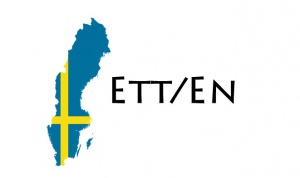Difference between revisions of "Language/Swedish/Grammar/When-use-Ett-or-En"
Jump to navigation
Jump to search
| Line 4: | Line 4: | ||
Hello everybody, | Hello everybody, | ||
In today's lesson you will learn | In today's lesson you will learn '''WHEN TO USE ETT & EN''' in Swedish. | ||
Feel free to edit this page by adding new words and expressions ! | Feel free to edit this page by adding new words and expressions ! | ||
| Line 10: | Line 10: | ||
Good learning ! :) | Good learning ! :) | ||
__TOC__ | |||
== ''' | == '''INDEFINITE FORM''' == | ||
In Swedish, we have two words to choose when we want to write about nouns in an indefinite form: En or Ett. | |||
'''Examples:''' | |||
*Ett bord = A table | |||
*En hund = A dog | |||
*Ett äpple = An apple | |||
*En skola = A school | |||
== '''COMMON MISTAKE''' == | |||
*En (Swedish article) = An (English article) | |||
*Ett (Swedish article) = A (English article) | |||
This is not true. There is '''no grammatical rule''' to know when to use En or Ett, you just simply '''have to learn them'''. | |||
== '''DEFINITE FORM''' == | |||
When we want a noun to be in definite form we add a suffix to the noun; -en, -n or -et. | |||
For example: | |||
*<u>Ett</u> bord = Bord<u>et</u> | |||
*<u>En</u> hund = Hund<u>en</u> | |||
*<u>Ett</u> äpple = Äppl<u>et</u> | |||
*<u>En</u> skola = Skola<u>n</u> | |||
<blockquote>Here we just add -n since the word already ends with a vowel.</blockquote> | |||
As you might have noticed, you can know which suffix to use by looking at the indefinite article. | |||
*If it's an "En-word", the suffix is -en or -n. | |||
*If it's an "Ett-word", the suffix is -et. | |||
== When to use ETT or EN in Swedish (table in several languages) == | |||
{| class="wikitable sortable" | {| class="wikitable sortable" | ||
|- | |- | ||
!'''<big>ENGLISH</big>''' | |||
!'''<big>SWEDISH</big>''' | |||
!'''<big>PRONUNCIATION IN</big>''' | |||
'''<big>ENGLISH</big>''' | '''<big>ENGLISH</big>''' | ||
!'''<big>BRAZILIAN</big>''' | |||
'''<big>PORTUGUESE</big>''' | '''<big>PORTUGUESE</big>''' | ||
|A table | |A table | ||
|'''<big>Ett bord</big>''' | |'''<big>Ett bord</big>''' | ||
| Line 75: | Line 98: | ||
|} | |} | ||
== | ==Videos== | ||
<youtube>w_Yrfx1nHLw</youtube> | |||
<youtube>jGi3LShBCp4</youtube> | |||
<youtube>FF1m6h3TddU</youtube> | |||
=='''Authors'''== | =='''Authors'''== | ||
[http://polyglotclub.com/member/brainwashme Brainwashme] | [http://polyglotclub.com/member/brainwashme Brainwashme] | ||
Revision as of 18:11, 8 September 2021
.
Hello everybody,
In today's lesson you will learn WHEN TO USE ETT & EN in Swedish.
Feel free to edit this page by adding new words and expressions !
Good learning ! :)
INDEFINITE FORM
In Swedish, we have two words to choose when we want to write about nouns in an indefinite form: En or Ett.
Examples:
- Ett bord = A table
- En hund = A dog
- Ett äpple = An apple
- En skola = A school
COMMON MISTAKE
- En (Swedish article) = An (English article)
- Ett (Swedish article) = A (English article)
This is not true. There is no grammatical rule to know when to use En or Ett, you just simply have to learn them.
DEFINITE FORM
When we want a noun to be in definite form we add a suffix to the noun; -en, -n or -et.
For example:
- Ett bord = Bordet
- En hund = Hunden
- Ett äpple = Äpplet
- En skola = Skolan
Here we just add -n since the word already ends with a vowel.
As you might have noticed, you can know which suffix to use by looking at the indefinite article.
- If it's an "En-word", the suffix is -en or -n.
- If it's an "Ett-word", the suffix is -et.
When to use ETT or EN in Swedish (table in several languages)
| ENGLISH | SWEDISH | PRONUNCIATION IN
ENGLISH |
BRAZILIAN
PORTUGUESE |
A table | Ett bord | eht bohr | Uma mesa |
|---|---|---|---|---|---|---|---|
| A dog | En hund | ehn hoon | Um cachorro | ||||
| An apple | Ett äpple | eht eh pleh | Uma maçã | ||||
| A school | En skola | ehn skoo lah | Uma escola | ||||
| The table | Bordet | bohr deht | A mesa | ||||
| The dog | Hunden | hoon dehn | O cachorro | ||||
| The apple | Äpplet | eh pleht | A maçã | ||||
| The school | Skolan | skoh lahn | A escola |
Videos

